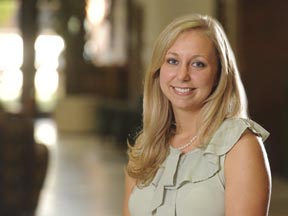A University of Alabama at Birmingham study reveals sleep-deprived adolescents are more likely to be hit by cars while crossing the street than those who are well-rested.
 “These 14- and 15-year-olds are perceived to be safe pedestrians, but we found that when they are sleepy they take more risks when crossing the street,” said Aaron Davis, M.A., author of the study and a doctoral candidate in the UAB Department of Psychology. “At this age they walk more because they can’t drive, and that is disconcerting because our results show they are 56 percent more likely to be hit by a car or experience a close call while crossing a street fatigued.”
“These 14- and 15-year-olds are perceived to be safe pedestrians, but we found that when they are sleepy they take more risks when crossing the street,” said Aaron Davis, M.A., author of the study and a doctoral candidate in the UAB Department of Psychology. “At this age they walk more because they can’t drive, and that is disconcerting because our results show they are 56 percent more likely to be hit by a car or experience a close call while crossing a street fatigued.”
Adolescents require more sleep, a minimum of 8.5 hours uninterrupted each night, than young children. Davis, whose work on this subject recently won the Student Poster Award at the Midwest Regional Conference on Pediatric Psychology, studied 55 adolescents in a virtual reality pedestrian environment at the UAB Youth Safety Lab. Student sleep was measured for two weeks by actigraphy. Participants wore the actigraph watch, and each was studied after sleeping four hours and eight and a half hours. The research revealed teens that slept four hours experienced more hits, more close calls and took more time to initiate crossings; however, adolescents with a full night sleep missed more safe opportunities to cross the street.
“It seems almost backward but sleep-deprived kids are crossing with less time between cars and the kids with more sleep are being more cautious and skip safe opportunities more often,” says Davis, chair of the Alabama Psychological Association of Graduate Students.
Every year 8,000 adolescents ages 14 and 15 require medical attention due to pedestrian injury. Sleep-deprived adolescents were hit or had a close call with a vehicle nearly 9 percent of the time when they crossed the street in UAB’s virtual environment.
“Aaron’s work demonstrates the importance of sleep for human functioning,” says David Schwebel, Ph.D., co-author and director of UAB Youth Safety Lab. “Our results show clearly that insufficient sleep influences adolescent safety, and without sufficient sleep they are inattentive, distractible and poor decision-makers.”
Davis’s poster is titled “The Effects of Sleep Restriction on Adolescents’ Pedestrian Safety.” Co-authors include Amanda Sessions, Anna Johnston, Kristin Avis, Ph.D., and Schwebel. Her work is supported by grants from the National Science Foundation and The Children’s Hospital of Philadelphia.
